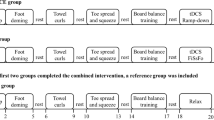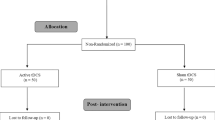Abstract
Foot-sole somatosensation is critical for safe mobility in older adults. Somatosensation arises when afferent input activates a neural network that includes the primary somatosensory cortex. Transcranial direct current stimulation (tDCS), as a strategy to increase somatosensory cortical excitability, may, therefore, enhance foot-sole somatosensation. We hypothesized that a single session of tDCS would improve foot-sole somatosensation, and thus mobility, in older adults. Twenty healthy older adults completed this randomized, double-blinded, cross-over study consisting of two visits separated by one week. On each visit, standing vibratory threshold (SVT) of each foot and the timed-up-and-go test (TUG) of mobility were assessed immediately before and after a 20-min session of tDCS (2.0 mA) or sham stimulation with the anode placed over C3 (according to the 10/20 EEG placement system) and the cathode over the contralateral supraorbital margin. tDCS condition order was randomized. SVT was measured with a shoe insole system. This system automatically ramped up, or down, the amplitude of applied vibrations and the participant stated when they could or could no longer feel the vibration, such that lower SVT reflected better somatosensation. The SVTs of both foot soles were lower following tDCS as compared to sham and both pre-test conditions [F(1,76) > 3.4, p < 0.03]. A trend towards better TUG performance following tDCS was also observed [F(1,76) = 2.4, p = 0.07]. Greater improvement in SVT (averaged across feet) moderately correlated with greater improvement in TUG performance (r = 0.48, p = 0.03). These results suggest that tDCS may enhance lower-extremity somatosensory function, and potentially mobility, in healthy older adults.




Similar content being viewed by others
References
Adolphs R, Damasio H, Tranel D, Cooper G, Damasio AR (2000) A role for somatosensory cortices in the visual recognition of emotion as revealed by three-dimensional lesion mapping. J Neurosci 20:2683–2690
Alonzo A, Brassil J, Taylor JL, Martin D, Loo CK (2015) Daily transcranial direct current stimulation (tDCS) leads to greater increases in cortical excitability than second daily transcranial direct current stimulation. Brain Stimul 5:208–213
Bachmann CG, Muschinsky S, Nitsche MA et al (2010) Transcranial direct current stimulation of the motor cortex induces distinct changes in thermal and mechanical sensory percepts. Clin Neurophysiol 121:2083–2089
Blankenburg F, Ruff CC, Bestmann S, Bjoertomt O, Eshel N, Josephs O, Weiskopf N, Driver J (2008) Interhemispheric effect of parietal TMS on somatosensory response confirmed directly with concurrent TMS–fMRI. J Neurosci 28:13202–13208
Boggio PS, Nunes A, Rigonatti SP, Nitsche MA, Pascual-Leone A, Fregni F (2007) Repeated sessions of noninvasive brain DC stimulation is associated with motor function improvement in stroke patients. Restor Neurol Neurosci 25:123–129
Boggio PS, Rigonatti SP, Ribeiro RB, Myczkowski ML, Nitsche MA, Pascual-Leone A, Fregni F (2008) A randomized, double-blind clinical trial on the efficacy of cortical direct current stimulation for the treatment of major depression. Int J Neuropsychopharmacol 11:249–254
Bolton CF, Winkelmann RK, Dyck PJ (1966) A quantitative study of Meissner’s corpuscles in man. Neurology 16:1–9
Borich MR, Brodie SM, Gray WA, Ionta S, Boyd LA (2015) Understanding the role of the primary somatosensory cortex: opportunities for rehabilitation. Neuropsychologia 79:246–255
Boubker Z, Edgley SA, Soteropoulos DS, Baker SN (2012) Changes in descending motor pathway connectivity after corticospinal tract lesion in macaque monkey. Brain 135:2277–2289
Brodoehl S, Klingner C, Stieglitz K, Witte OW (2013) Age-related changes in the somatosensory processing of tactile stimulation—An fMRI study. Behav Brain Res 238:259–264
Brunoni AR, Amadera J, Berbel B, Volz MS, Rizzerio BG, Fregni F (2011) Systematic review on reporting and assessment of adverse effects associated with transcranial direct current stimulation. Int J Neuropsychopharmacol 14:1133–1145
Citaker S, Gunduz AG, Guclu MB, Nazliel B, Irkec C, Kaya D (2011) Relationship between foot sensation and standing balance in patients with multiple sclerosis. Gait Posture 34:275–278
Davis NJ, Gold E, Pascual-Leone A, Bracewell RM (2013) Challenges of proper placebo control for non-invasive brain stimulation in clinical and experimental application. Eur J Neurosci 38:2973–2977
Eils E, Nolte S, Tewes M, Thorwesten L, Völker K, Rosenbaum D (2002) Modified pressure distribution patterns in walking following reduction of plantar sensation. J Biomech 35:1307–1313
Eils E, Behrens S, Mers O, Thorwesten L, Völker K, Rosenbaum D (2004) Reduced plantar sensation causes a cautious walking pattern. Gait Posture 20:54–60
Fregni F, Pascual-Leone A (2007) Technology insight: noninvasive brain stimulation in neurology—perspectives on the therapeutic potential of rTMS and tDCS. Nat Clin Pract Neuro 3:383–393
Gandiga PC, Hummel FC, Cohen LG (2006) Transcranial DC stimulation (tDCS): a tool for double-blind sham-controlled clinical studies in brain stimulation. Clin Neurophysiol 117:845–850
Gilbert CD, Sigman M (2007) Brain states: top-down influences in sensory processing. Neuron 54:677–696
Goldberg RF, Perfetti CA, Schneider W (2006) Perceptual knowledge retrieval activates sensory brain regions. J Neurosci 26:4917–4921
Kavounoudias A, Roll R, Roll JP (2001) Foot sole and ankle muscle inputs contribute jointly to human erect posture regulation. J Physiol 532:869–878
Kristinsdottir EK, Fransson PA, Magnusson M (2001) Changes in postural control in healthy elderly subjects are related to vibration sensation, vision and vestibular asymmetry. Acta Otolaryngol 121:700–706
Kuypers HG (1981) Anatomy of the descending pathways. In: Brooks VB (ed) Handbook of physiology, sect 1, vol 11. Am Physiol Soc, Bethesda, MD, pp 597–666
Legon W, Dionne JK, Staines WR (2013) Continuous theta burst stimulation of the supplementary motor area: effect upon perception and somatosensory and motor evoked potentials. Brain Stimul 6:877–883
Lipsitz LA, Lough M, Niemi J, Travison T, Howlett H, Manor B (2015) A shoe insole delivering subsensory vibratory noise improves balance and gait in healthy elderly people. Arch Phys Med Rehab 96:432–439
Lord SR, Clark RD, Webster IW (1991) Postural stability and associated physiological factors in a population of aged persons. J Gerontol 46:M69–M76
Malandraki GA, Perlman AL, Karampinos DC, Sutton BP (2011) Reduced somatosensory activations in swallowing with age. Hum Brain Mapp 32:730–743
Maldjian JA, Gottschalk A, Patel RS, Pincus D, Detre JA, Alsop DC (1999) Mapping of secondary somatosensory cortex activation induced by vibrational stimulation: an fMRI study. Brain Res 824:291–295
Manchester D, Woollacott M, Zederbauer-Hylton N, Marin O (1989) Visual, vestibular and somatosensory contributions to balance control in the older adult. J Gerontol 44:M118–M127
Martin JH (2005) The corticospinal system: from development to motor control. Neuroscientist 11:161–173
Meehan SK, Linsdell MA, Handy TC, Boyd LA (2011) Interhemispheric enhancement of somatosensory cortical excitability through contralateral repetitive transcranial magnetic stimulation. Clin Neurophysiol 122:1637–1644
Menz HB, Lord SR, St George R, Fitzpatrick RC (2004) Walking stability and sensorimotor function in older people with diabetic peripheral neuropathy. Arch Phys Med Rehabil 85:245–252
Meyer PF, Oddsson LI, De Luca CJ (2004) The role of plantar cutaneous sensation in unperturbed stance. Exp Brain Res 156:505–512
Miranda PC, Mekonnen A, Salvador R, Ruffini G (2013) The electric field in the cortex during transcranial current stimulation. Neuroimage 15:48–58
Miranda DL, Hsu WH, Gravelle DC, Petersen K, Ryzman R, Niemi J, Lesniewski-Laas N (2016a) Sensory enhancing insoles improve athletic performance during a hexagonal agility task. J Biomech 49:1058–1063
Miranda DL, Hsu WH, Petersen K, Fitzgibbons S, Niemi J, Lesniewski-Laas N, Walsh CJ (2016b) Sensory enhancing insoles modify gait during inclined treadmill walking with load. Med Sci Sport Exerc 48:860–868
Mori F, Nicoletti CG, Kusayanagi H, Foti C, Restivo DA, Marciani MG, Centonze D (2013) Transcranial direct current stimulation ameliorates tactile sensory deficit in multiple sclerosis. Brain Stimul 6:654–659
Nitsche MA, Paulus W (2000) Excitability changes induced in the human motor cortex by weak transcranial direct current stimulation. J Physiol 527:633–639
Nitsche MA, Paulus W (2001) Sustained excitability elevations induced by transcranial DC motor cortex stimulation in humans. Neurology 57:1899–1901
Nitsche MA, Cohen LG, Wassermann EM et al (2008) Transcranial direct current stimulation: state of the art. Brain Stimul 1:206–223
Oldfield RC (1971) The assessment and analysis of handedness: the Edinburgh inventory. Neuropsychologia 9:97–113
Podsiadlo D, Richardson S (1991) The timed “up and go”: a test of basic functional mobility for frail elderly persons. J Am Geriatr Soc 39:142–148
Ragert P, Vandermeeren Y, Camus M, Cohen LG (2008) Improvement of spatial tactile acuity by transcranial direct current stimulation. Clin Neurophysiol 119:805–811
Reis J, Schambra HM, Cohen LG et al (2009) Noninvasive cortical stimulation enhances motor skill acquisition over multiple days through an effect on consolidation. Proc Natl Acad Sci USA 106:1590–1595
Richardson JK, Ching C, Hurvitz EA (1992) The relationship between electromyographically documented peripheral neuropatny and falls. J Am Geriatr Soc 40:1008–1012
Ruffini G, Fox MD, Ripolles O, Miranda PC, Pascual-Leone A (2014) Optimization of multifocal transcranial current stimulation for weighted cortical pattern targeting from realistic modeling of electric fields. Neuroimage 89:216–225
Scaglioni G, Ferri A, Minetti AE et al (2002) Plantar flexor activation capacity and H reflex in older adults: adaptations to strength training. J Appl Physiol 92:2292–2302
Selvarajah D, Wilkinson ID, Maxwell M et al (2014) Magnetic resonance neuroimaging study of brain structural differences in diabetic peripheral neuropathy. Diabetes Care 37:1681–1688
Seyal M, Ro T, Rafal R (1995) Increased sensitivity to ipsilateral cutaneous stimuli following transcranial magnetic stimulation of the parietal lobe. Ann Neurol 38:264–267
Shaffer SW, Harrison AL (2007) Aging of the somatosensory system: a translational perspective. Phys Ther 87:193–207
Shumway-Cook A, Brauer S, Woollacott M (2000) Predicting the probability for falls in community-dwelling older adults using the timed up and go test. Phys Ther 80:896–903
Tesfaye S, Selvarajah D (2012) Advances in the epidemiology, pathogenesis and management of diabetic peripheral neuropathy. Diabetes Metab Res Rev 28:8–14
Wang Y, Hao Y, Zhou J et al (2015) Direct current stimulation over the human sensorimotor cortex modulates the brain’s hemodynamic response to tactile stimulation. Eur J Neurosci 42:1933–1940
Zhang M, Mariola E, Stilla R et al (2005) Tactile discrimination of grating orientation: fMRI activation patterns. Hum Brain Mapp 25:370–377
Zhou J, Lipsitz L, Habtemariam D, Manor B (2016) Sub-sensory vibratory noise augments the physiologic complexity of postural control in older adults. J Neuroeng Rehabil 13:44
Acknowledgements
We would like to thank Dr. Xiaohong Chen in Capital University of Physical Education and Sports for the help of participant recruitment. This study was supported by Grants from the National Natural Science Foundation of China (Grant number 11572003 and 11372013), and the National Institute on Aging (AG025037, AG041785, and 1-K01-AG044543-01A1). Dr. Lipsitz holds the Irving and Edyth S. Usen and Family Chair in Geriatric Medicine at Hebrew SeniorLife. Dr. Junhong Zhou is supported by the Irma and Paul Milstein Program for Senior Health Fellowship Award from Milstein Medical Asian American Partnership (MMAAP) Foundation.
Author information
Authors and Affiliations
Corresponding authors
Ethics declarations
Conflict of interest
All the authors disclose no conflict of interest.
Rights and permissions
About this article
Cite this article
Zhou, J., Lo, OY., Lipsitz, L.A. et al. Transcranial direct current stimulation enhances foot sole somatosensation when standing in older adults. Exp Brain Res 236, 795–802 (2018). https://doi.org/10.1007/s00221-018-5178-6
Received:
Accepted:
Published:
Issue Date:
DOI: https://doi.org/10.1007/s00221-018-5178-6




